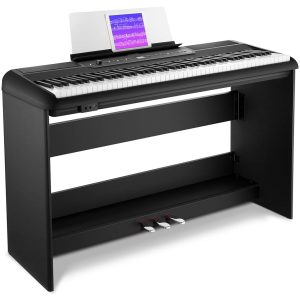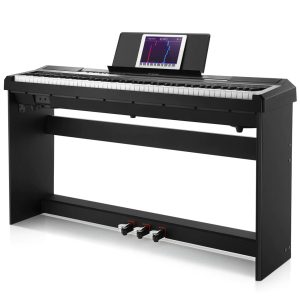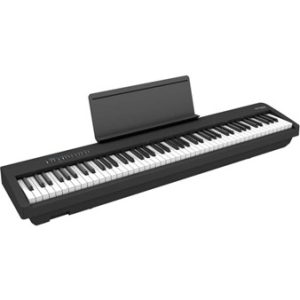History
The idea of building a compact and portable piano is not new. In the 1600s, for example, there was the clavichord, a small and relatively quiet type of piano. So-called “silent pianos,” which fold for easier transport and storage, were also present. The first electric pianos appeared about fifty years ago, in the late ’60s. At that time, Fender, with the Rhodes model, and Wurlitzer introduced the first stage pianos to the market. Although they didn’t sound like a real piano, their distinctive sound has since become an integral part of pop music.
In the following years, companies like Roland began experimenting with portable electronics that functioned similarly to a classic piano. The real innovation came in the late 1980s with the Kurzweil 250, which, for the first time, used sampling techniques to reproduce piano sounds, giving birth to the digital stage piano.
Construction
Stage pianos are often very different from digital pianos designed for home use. They don’t need to have a rich wooden appearance. Stage pianos have a simpler but durable design, with switches, buttons, and a screen that is easy to use even in low lighting conditions.
An important feature for electric pianos is the 3 pedals, which are often connected or integrated into the rest of the piano frame – the wooden base. On the other hand, stage pianos have the pedals placed separately. Some stage pianos may not provide pedals, so if this is the case, you’ll need to purchase them separately. While digital pianos usually come with a wooden base, stage pianos do not. Typically, stage pianos are placed on special stands with double legs.

The Keyboard
Usually, the keyboard of a stage piano has 88 weighted keys, aiming to reproduce the feel of a classic piano. To achieve this, the keys are not only heavy, but manufacturers make great efforts to replicate the hammer mechanism of acoustic models as closely as possible.
However, the feel of a keyboard is a matter of preference. For this reason, whenever possible, you should take the opportunity to try out various models before making a purchase. In our physical store in Katerini, at 41 Terzopoulou Street, you will always find a wide variety of stage pianos to try. Generally, those with a more classical educational background prefer a keyboard with more resistance, while digital keyboard players feel more comfortable with “lighter” keys. It’s good to try it out and see what you like.
Companies like Donner, Casio, and Roland offer models with 88 weighted keys, which make up the majority. When deciding which model is suitable for you, consider how you plan to use it and the perspective you will have.
The Sound
The first thing a stage piano should offer is a good variety of acoustic and digital piano sounds. Thanks to the rapid progress of digital technology, most models can achieve this with very good quality. However, there are pianos, in the higher price range, that offer particularly authentic acoustic sounds and more refined details. The quantity of available piano sounds is often more crucial. For example, rock and pop music demand pianos with high notes and a bold tone, while ballads or even jazz tend towards softer, more natural piano sounds. Ideally, a stage piano offers at least two or three different acoustic pianos. However, the quality of the samples can vary significantly, with cheaper models reproducing a less “natural” result.
If you have specific requirements regarding sounds, you should check before purchasing whether the stage piano you are considering has what you are looking for. The variety of sounds offered varies significantly between models. At the lower end, only 32 sounds may be offered, while top models usually offer over 300 different sounds. Some top models, such as those from Roland, even have the ability to add more sounds via expansion cards.
Thanks to modern DSP technology, the number of “voices” – polyphony – offered in today’s stage pianos is not as crucial. Even mid-range models have 128 or 192 notes of polyphony. The term polyphony refers to how many notes can be sounded simultaneously. The technical capabilities of an electronic instrument are limited, like in a computer, by the capacity of the integrated processing units (chips). The more notes need to be controlled, the more data the processor needs to process.
Functions
MIDI
The MIDI (Musical Instrument Digital Interface) function is a data transfer protocol that allows the communication, recording, or playback of digital information between the digital/stage piano and a computer or hardware device. Many digital pianos feature a MIDI interface, usually with both an input and an output (MIDI-IN and MIDI-OUT) or a USB port. This allows you to connect to a computer equipped with recording software. Another option, using suitable software on the computer, would be to have the computer play the sheet music while you are playing a piece, which you can then save or print.
Arranger
The “Arranger” function is a feature that enables the player to accompany the melody (while playing) with various rhythmic styles. With the press of a button, an entire band or orchestra can be simulated according to the player’s chosen rhythms and styles.
The Panel, Screen, and Controls
When selecting a digital piano, you should ensure that the buttons, sliders, front panel, and the overall controls are easily accessible during play. For example, is it easy to switch between sound settings? Can you select built-in effects and other functions with the press of a single button? Is there a touch screen displaying your selections for easier navigation? Or are all parameters only selectable through a small LCD screen? Make sure the instrument will do what you want during play!

Pedals
Usually, pedals are not included with stage pianos, except for the basic sustain pedal, unless a stage piano comes with its wooden stand featuring three pedals. In this case, the stage piano is placed on top of the wooden stand and can be detached at any time for standalone use if needed. If you need to purchase additional pedals, make sure that the stage piano you have has the appropriate inputs/sockets. Many stage pianos in the more affordable category are only compatible with the basic sustain pedal, which is not a significant issue, especially for beginners in the early years of learning. However, if you need something more, pay attention to stability and construction when making a purchase, as pedals will be used extensively throughout their lifespan. Additionally, they should not constantly slide on smooth surfaces and should remain stable during use.
Connectivity
Stage pianos come with various connections, and the most important ones are the audio outputs. They often feature a jack socket as a stereo output that can be used with headphones for silent practice. More expensive models may also have integrated XLR sockets for connecting to mixers or microphones. The MIDI interface, usually with an input and an output (MIDI-IN and MIDI-OUT) or a USB port, allows you to connect to a computer equipped with recording software. Another option, using suitable software on the computer, would be that while playing a piece, the computer reproduces the sheet music, which you can save or print via the computer.
Transportation
A good stage piano weighs over 15kg, so for secure transportation, there is only one option: the flight case! It might not be the cheapest choice, but it’s perhaps the safest. However, there are also soft cases for stage pianos with padding and shoulder/back straps – suitable for transporting instruments that weigh under 20kg.
Conclusion
Beyond all the features and capabilities that each model offers, the most important thing to consider when buying a stage piano is how you feel when you play it and whether you are satisfied with the sound quality it produces. Both of these elements are judged based on your preferences and are often interrelated. Before purchasing a stage piano or any digital piano, it is recommended to try as many models as possible. In our physical store in Katerini, located at 41 Terzopoulou Street, you will always find a wide variety of stage pianos to try. If you have any questions, we are here to help!




